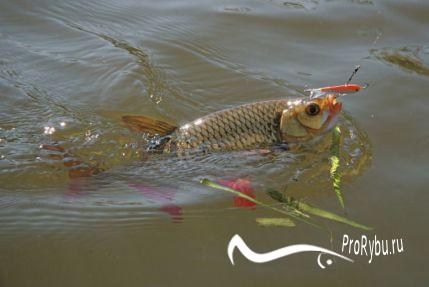Sea perch (lat. Sander marinus), Bernie (Azerbaijan), perch (Turkmenistan), Bukovec (the Dnieper – bug Liman) is a species of ray-finned fish of the perch family (Percidae).
Visually, the sea perch is very slightly different from its common relative. The body is painted in a light gray color, on sides well marked transverse dark bands.
Overall description fish perch common is true for the sea bass. The only difference in size. Although the body length is quite substantial (50-60 cm), body weight usually does not exceed 2 kg. All because the torso he has a very elongated and flattened laterally. On the jaws there are also klinovidnye teeth, but not as impressive as that of the common perch.
In the dorsal fin of not more than 18 branched rays. The forehead is wider than transverse diameter of eye.
The spines of the anal fin weak, and closely adjacent to the soft parts (unlike the pike perch, lucioperca L., and bersh, L. volgensis), cheeks naked or nearly naked.



Has fangs (unlike L. volgensis).
Lateral line 75-88.
Vertebrae 42-44.
In Russia, pike – perch, lucioperca L., and bersh, L. volgensis. Especially close American Sanders – L. canadensis and L. vitrea.
There are two isolated habitat of this species, which gives us, in fact, two separate populations. The first population lives in the northwestern part of the Black sea, where a fall in such large rivers as the Dnieper, southern bug, Dniester and Danube. Moreover, the perches do not love to go to freshwater estuaries, and are permanent inhabitants. Sometimes they even swim directly into the mouths of the rivers.
The second population inhabits the Caspian sea. Local specimens have some slight differences in appearance from the black sea. In addition, the Caspians on the contrary, they avoid to appear in the desalinated parts of the sea, for example, near the Volga Delta.
Middle and South Caspian sea from Makhachkala to Pahlavi in the West and from Mangyshlak to the island of Caspian sea in the East. Numerous sea perch in the West from Sumgait to And the old and the Islands Residential, Artem, Kura stone and Baku archipelago and off the Eastern coast of the Caspian sea from Karabogaz-goals to the Krasnovodsk Gulf. In the Black sea it inhabits the Dnieper-bug estuary.
Sea perch, found in the Caspian sea, lives in the sea. It is not included in the river and avoids the desalinated areas. From the Dnieper-bug estuary unit enters the mouth of the Dnieper and bug.
Caspian sea perch darker the black sea “bukovca”. It forms herds, associated with the centers of reproduction (O. Residential, Kura stone, off the coast of Turkmenistan and Mangyshlak). Fish these herds are slightly different ratios of the parts of the head and dimensions of the fins.
Lives near the bottom on dense soils in the coastal zone, mainly at depths of’ up to 35 m, rarely 100 m.
The spawning of the Caspian sea perch occurs in April-may at a depth of from 3 to 12 m, on rocky areas. The peak of spawning at water temperatures of 15-16°. Fertility 13-126 thousand, an average of 45 thousand eggs (fish length 26-47 cm).
The sticky eggs, larger than those of walleye. In September young of the year reach the average length of 9.3 cm and weight of 15 g.
Sea perch reaches the Black sea length (abs.) 54 cm, in the Caspian – 62 cm In catches dominated by fish aged three to five years, their length 26-35 cm, weight 340-800 g.
Females grow faster than males. First spawning is at the age of three to four years from the few at the age of two years.
Sea perch feeds on gobies, sardines, atitinkamai, young herring, crayfish, shrimp.
Competitors. Partly sturgeon and seal.
Enemies. Gobies eating eggs sea bass.
In Northern Azerbaijan and the Eastern coast of the Caspian sea migration the sea perch mainly approaches it in a coastal area in March – may for spawning (mainly when the water temperature 11-16°) and September – December for fattening. In winter, when cooling of the coastal waters, and in the summer when strong heating, a large portion of sea bass, moving away from the coast.
In Azerbaijan often, a large number of its remains off the coast. When ripe the sexual products to stages IV and IV-V sea perch approaching to the shore, where the first rests on the sandy and Shelly grounds, and then for spawning goes to rocky ridges.
During the retreat from the coast or the approach to them is going to break in depths of 20-50 m. Winter a number of sea perch holds among the rocks, part of the fish is kept in isolation, extending to depths of 100 m On the Eastern coast of the Caspian sea is weakly pronounced summer (July – August) the South, the lake to Caspian sea.
Wineservice sea perch does not fit in the autumn to the coast, and migrates to the South (at depths of 16-100 m), reaching Iran. Spring is concentrated off the coast of South Azerbaijan. Juveniles from the age of two migrated with Mature.
The value of small. The catch in the Caspian sea in 1936-1942 he averaged about 25 thousand centners a year, including in Azerbaijan from 5 to 15.2 thousand C, in Turkmenistan from 4.7 to 17.8 thousand kg. In the Black sea (the Dnieper-bug estuary) sea perch is very small. Catches in the Caspian sea can be slightly increased.
Technique and the course of the fishery. Catch sea bass all year round (main gear spring and autumn) set net “mousetrap”, skepasti, fixed and, rarely, a zakidnogo Seine nets (in the spring).
Use. Most of the catch is salted. Part of it is frozen or marketed in chilled form. A small amount is used for production of canned goods (“pike-perch in tomato sauce”).


